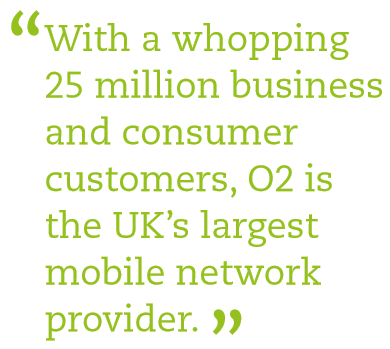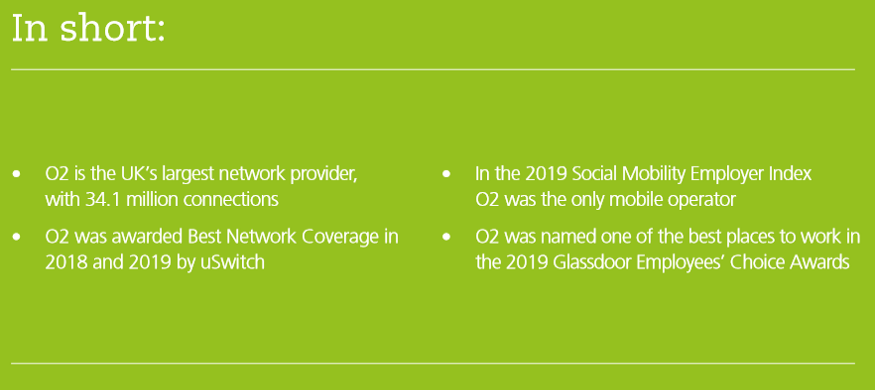Extract from Customer Focus Magazine: Issue 28 (Jan 2020)
The higher you climb, the further you have to fall. Mark Gait talks to Customer Focus about how the best way to fight increased customer expectation is to use ever more technological innovation.
Mark Gait, director of customer service at O2 (Telefónica UK), certainly has a point: ‘If you were to summarise the last ten years that The Institute’s Customer Satisfaction Index has been around for,’ he says , ‘the fundamentals of service haven’t really changed at all. Customers want their lives to be made simple and easy,’ he adds, ‘and when they do need to get in touch, they want their interactions to be personal.’ But what has changed significantly, he accepts is the evolving nature of one simple word — expectation: ‘Meeting this has undoubtedly gotten harder,’ says Gait, who has headed service at the company since 2014, but has enjoyed more than just a little bit of success getting it right. In 2015, O2 topped regulator Ofcom’s Customer Satisfaction Survey, with an average satisfaction rating of 80%. This was significantly higher than the sector’s overall 72% rating, and all achieved at a time when O2 was rapidly adding to its customer base. (With complaints for the sector measured on a per 100,000 customers basis, improving service while at the same time growing customer numbers is a significant achievement). Today, with a whopping 25 million business and consumer customers, O2 is the UK’s largest mobile network provider yet according to Ofcom’s latest (November 2019) data, it attracts just two complaints per 100,000 customers. Virgin Mobile meanwhile has eight, and Vodafone and BT Mobile get six (the sector average is three).
The higher O2 reaches though, the further it has to fall, and according to Gait, if the next ten years is to be just as successful, customer service innovation has to be the name of the game. ‘It’s the piece around how we exceed expectations — rather than just meeting certain minimum standards — that’s all-important,’ he argues. ‘And where we have to exceed is in the area of direct customer contact.’
According to Gait, the recent trend for falling customer voice calls has been no different at O2, but it actually means his whole strategy around voice has to be even better. ‘Back in 2010, we were getting somewhere in the region of 1m calls to the contact centre per week,’ he says. ‘As we speak, this figure is more like 300,000 — a fall even more remarkable when you account for the fact we’ve added another 5m customers since then.’
A lot of this is explained, he says by the fact that generally, everything has gotten easier for customers: ‘New phones are easier to set up; contracts have limitless minutes, texts and data, and billing is more straightforward. In essence, people have less need to call up to have queries dealt with.’
But what’s also gotten easier (especially with the government’s new ‘text and switch’ facility introduced in the summer of 2019), is the ability for customers to take their business elsewhere, so nothing from a service point of view can be left to chance. ‘We’re starting to say that our contact centres will be “the home of the complex,”’ He says ‘that is, the place where all the things customers can’t sort out by themselves will need to be dealt with. Right now,’ he says, ‘we’re working out exactly what this means.’
Developing new ways to bring evermore innovation into the mix, is certainly one way this thinking is going. ‘Most customer interaction is already going through our “My O2” app, but we still see voice as being integral,’ he says. ‘It’s why we introduced our Visual IVR system in 2016. Here, when callers phone up, voice recognition technology matches them to the person in the contact centre it best thinks can manage the call. At the same time, a text is sent to the caller, giving them the option to self-serve (i.e. use the My O2 app to do their transaction) — or if not, the call is kept open, and the query is dealt with by contact centre staff.’
According to usage data, this innovation alone has had transformative results: via the app customers are able to complete eight transactions (such as paying their bill or updating their address details if they’ve moved), eight times faster than if they’d had to go through the various processes on the phone with an agent. Around 99% of people using it don’t need a follow-up call, and call times have been reduced by an average of 100 seconds. Tasks like payment processing can now be done in just 34 seconds. ‘Visual IVR first tries to take people into a self-service option, because it’s what more digitally savvy people like,’ says Gait. But even here, he’s not satisfied.
‘This whole area of customer interaction is moving so fast, that we don’t think things will stay like this for long,’ he argues. ‘Future success will come via not even having an IVR process at all,’ he predicts. ‘We’re right now looking at how AI can make this whole process of getting to the right person, completely invisible to customers calling up.’ He explains: ‘For instance, a data-led approach might be able to tell that a person has complained about X before, or is still in their upgrade period, and so makes a decision that this is the most likely reason for the person calling, and directs them to a dedicated handler to deal with this. Sure, it might not always work, but this is how I see the future panning out. I’m not even saying this is a decade away — I’m talking one-to-two years.’
Given that Ofcom data shows 47.57% of complaints are for billing and customer service issues, a win in this area would, he says, make a noticeable difference. ‘From a business case point of view, technology and innovation on this level really does stack up,’ he says.
A benefit Gait has in being able to think about the future, is drawing upon the resources of fellow Institute member Capita, the group O2 signed a ten-year outsourcing agreement with in 2013 to handle most of its incoming service calls. Today it receives about 80% of all customer calls. ‘They have technological advancements that we’re able to bring to our business,’ he says. ‘In partnering with them, we almost expect them to bring this sort of thinking to us.’ He adds: ‘Ultimately, I just don’t think people like IVR at all. So why not introduce a situation where we can have the correct first outcome?’
As contact centres do morph into becoming home of the complex, it’s imperative operators don’t get left behind too, and according to Gait, work is also being started on thinking about what the ‘advisor of the future’ (including what qualities they will have), will be. Says Gait: ‘We have worked with Capita around the hiring of call centre staff — showing them in advance what the job will be, before they’ve even been hired. This way they better understand their role talking to customers.’
Some might argue all of this is overkill — O2 does, after all, have a stunning customer churn rate of just 1%. But, Gait argues, having lots of small attention to detail adds up to a greater whole. ‘We can never be complacent,’ he says. ‘It’s when you stand still that people vote with their feet. Today it’s never been so easy for people to take custom elsewhere. It’s vital we take the customer service lead, rather than be the ones who follow.’
For its part, Gait says The Institute’s UKCSI has been extremely helpful, especially in the way it reminds him to stay present and focused. ‘The one thing you can take from the UKCSI is that now, it’s effectively become a ten-year study into the customer service for lots of brands,’ he says. ‘While you always want to do the best yourself, you have to admire those consistently achieving companies (see first direct, p8), who despite having to face their own pressures, still manage to keep their service standards high, if not higher than the previous year.’ He adds: ‘The mark of a great service-orientated company is one that manages to stay high for service, even though they might be experiencing huge pressures in their own markets.’
For O2, its exciting future is the roll out of 5G — and to do it, it’s even entering into network sharing agreements with rival providers, to ensure fast and fault-free coverage is achieved. And yes, once this becomes the new norm, Gait says, he fully expects to have to reset O2’s service levels once again. ‘That’s the beauty of service,’ he says. ‘It never really stops. 5G will make things feel different once again for customers. Mark my word though; knowing when to hand over power to customers, to let them complete transactions, and when to withhold this, and offer help via service centres; this will be what everyone will be grappling with. We’re not saying we have the answer ourselves yet, but it’s a journey we’re definitely moving along.’



